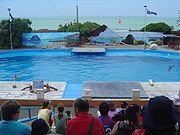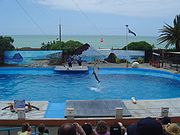
Marineland, Napier
Encyclopedia
Marineland of New Zealand is a marine mammal park
in Napier
, New Zealand
. The park opened in 1965 and closed to the public in 2008. It has had several species of native marine wildlife, including the common dolphin
, the New Zealand fur seal
, little blue penguin
and gannet
s. Marineland also has California sea lion
s, a sulphur crested cockatoo
, otter
s and more.
 The history of Marineland began in 1964 when an Auckland architectural firm was commissioned by Napier City under mayor Peter Tait to design an aquarium and dolphin pool. In late January 1965 Marineland caught its first common dolphin
The history of Marineland began in 1964 when an Auckland architectural firm was commissioned by Napier City under mayor Peter Tait to design an aquarium and dolphin pool. In late January 1965 Marineland caught its first common dolphin
, Daphne, and the facility opened two days later. In 1969 two dolphins died when vandals broke in and fed them nails.
By the end of the 1960s the site had exhibited dusky dolphins, Californian sea lions, leopard seal
s and New Zealand fur seal
s.
s and weddell seal
s welcomed to the site. In 1976 four small clawed otter
s arrived from Melbourne Zoo
. A year later the current General Manager, Gary Macdonald was appointed.


Marine mammal park
A marine mammal park is a commercial theme park or aquarium where marine mammals such as dolphins, beluga whales and sea lions are kept within water tanks and displayed to the public in special shows. A marine mammal park is more elaborate than a dolphinarium, because it also features other marine...
in Napier
Napier, New Zealand
Napier is a New Zealand city with a seaport, located in Hawke's Bay on the eastern coast of the North Island. The population of Napier is about About 18 kilometres south of Napier is the inland city of Hastings. These two neighboring cities are often called "The Twin Cities" or "The Bay Cities"...
, New Zealand
New Zealand
New Zealand is an island country in the south-western Pacific Ocean comprising two main landmasses and numerous smaller islands. The country is situated some east of Australia across the Tasman Sea, and roughly south of the Pacific island nations of New Caledonia, Fiji, and Tonga...
. The park opened in 1965 and closed to the public in 2008. It has had several species of native marine wildlife, including the common dolphin
Common dolphin
The common dolphin is the name given to two species of dolphin making up the genus Delphinus.Prior to the mid-1990s, most taxonomists only recognised one species in this genus, the common dolphin Delphinus delphis...
, the New Zealand fur seal
Fur seal
Fur seals are any of nine species of pinnipeds in the Otariidae family. One species, the northern fur seal inhabits the North Pacific, while seven species in the Arctocephalus genus are found primarily in the Southern hemisphere...
, little blue penguin
Penguin
Penguins are a group of aquatic, flightless birds living almost exclusively in the southern hemisphere, especially in Antarctica. Highly adapted for life in the water, penguins have countershaded dark and white plumage, and their wings have become flippers...
and gannet
Gannet
Gannets are seabirds comprising the genus Morus, in the family Sulidae, closely related to the boobies.The gannets are large black and white birds with yellow heads. They have long pointed wings and long bills. Northern gannets are the largest seabirds in the North Atlantic, with a wingspan of up...
s. Marineland also has California sea lion
Sea Lion
Sea lions are pinnipeds characterized by external ear-flaps, long fore-flippers, the ability to walk on all fours, and short thick hair. Together with the fur seal, they comprise the family Otariidae, or eared seals. There are six extant and one extinct species in five genera...
s, a sulphur crested cockatoo
Cockatoo
A cockatoo is any of the 21 species belonging to the bird family Cacatuidae. Along with the Psittacidae and the Strigopidae , they make up the parrot order Psittaciformes . Placement of the cockatoos as a separate family is fairly undisputed, although many aspects of the other living lineages of...
, otter
Otter
The Otters are twelve species of semi-aquatic mammals which feed on fish and shellfish, and also other invertebrates, amphibians, birds and small mammals....
s and more.
1960s

Common dolphin
The common dolphin is the name given to two species of dolphin making up the genus Delphinus.Prior to the mid-1990s, most taxonomists only recognised one species in this genus, the common dolphin Delphinus delphis...
, Daphne, and the facility opened two days later. In 1969 two dolphins died when vandals broke in and fed them nails.
By the end of the 1960s the site had exhibited dusky dolphins, Californian sea lions, leopard seal
Leopard Seal
The leopard seal , also referred to as the sea leopard, is the second largest species of seal in the Antarctic...
s and New Zealand fur seal
New Zealand Fur Seal
The Australian fur seal , or New Zealand fur seal or southern fur seal, is a species of fur seal found around the south coast of Australia, the coast of the South Island of New Zealand, and some of the small islands to the south and east of there...
s.
1970s
The year 1970 saw bottlenose dolphinBottlenose Dolphin
Bottlenose dolphins, the genus Tursiops, are the most common and well-known members of the family Delphinidae, the family of oceanic dolphins. Recent molecular studies show the genus contains two species, the common bottlenose dolphin and the Indo-Pacific bottlenose dolphin , instead of one...
s and weddell seal
Weddell Seal
The Weddell seal , is a relatively large and abundant true seal with a circumpolar distribution surrounding Antarctica. Weddell seals have the most southerly distribution of any mammal, with a habitat that extends as far south as McMurdo Sound...
s welcomed to the site. In 1976 four small clawed otter
Otter
The Otters are twelve species of semi-aquatic mammals which feed on fish and shellfish, and also other invertebrates, amphibians, birds and small mammals....
s arrived from Melbourne Zoo
Melbourne Zoo
The Royal Melbourne Zoological Gardens, commonly known as the Melbourne Zoo, contains more than 320 animal species from Australia and around the world. The zoo is north of the centre of Melbourne. It is accessible via Royal Park station on the Upfield railway line, and is also accessible via tram...
. A year later the current General Manager, Gary Macdonald was appointed.
1980s
A new grandstand was built and Marineland saw yellow-eyed penguins and little blue penguins lay eggs for the first time including some successful hatchings.1990s
A New Zealand Lotteries Commission grant was given for a new Marine Education Centre in 1991 and one year later a "Swim With Dolphins" programme began. In 1996 vandals broke in to the site for a second time. Redevelopments of many areas and accommodations for animals at the site took place.Animals


- Common DolphinCommon dolphinThe common dolphin is the name given to two species of dolphin making up the genus Delphinus.Prior to the mid-1990s, most taxonomists only recognised one species in this genus, the common dolphin Delphinus delphis...
- Kelly - She arrived on 13 December 1974, died on 11 September 2008. Early findings indicate cause of death may be due to stomach cancer as per this report. He death triggered the closure of Maineland
- Shona - Arrived on 13 December 1974, died on 7 April 2006 due to old age.
- California sea lionCalifornia Sea LionThe California sea lion is a coastal sea lion of western North America. Their numbers are abundant , and the population continues to expand about 5% annually. They are quite intelligent and can adapt to man-made environments...
: Where housed in pools totaling over 600,000 litres. They are used in daily shows along with the dolphins.- Rosey - She was born at Marineland in 1984 and is a fully mature breeding female. Has now died.
- Makea - Born on 15 December 1990 and is a fully trained show animal.
- Cody - Makea's younger sister, born on 17 December 1991. Has now died.
- Trinity (born at M. Napier on 17 December 1997. He was successfully hand raised by the staff after being rejected by his mother.
- Orion - Born at M.Napier on 22 December 1997 and will be trained to be a show animal.
- Dakota - Youngest female sea lionSea LionSea lions are pinnipeds characterized by external ear-flaps, long fore-flippers, the ability to walk on all fours, and short thick hair. Together with the fur seal, they comprise the family Otariidae, or eared seals. There are six extant and one extinct species in five genera...
who was born on 12 December 2004. She is now weaned, and in training for our daily shows. - Rufus - The newest addition to Marineland's sea lionSea LionSea lions are pinnipeds characterized by external ear-flaps, long fore-flippers, the ability to walk on all fours, and short thick hair. Together with the fur seal, they comprise the family Otariidae, or eared seals. There are six extant and one extinct species in five genera...
family. He was born on 22 December 2004. He has also been weaned and has begun his show training.
- New Zealand Fur SealNew Zealand Fur SealThe Australian fur seal , or New Zealand fur seal or southern fur seal, is a species of fur seal found around the south coast of Australia, the coast of the South Island of New Zealand, and some of the small islands to the south and east of there...
: Had either been brought in sick or injured, or have been bred from animals brought to the park sick and injured.- Angel - Brought into Marineland on 12 June 1991. He is now retired from the shows, but participates in the Marine Animal Encounter Tours. Angel died on the 27 July 2009.
- Primrose - She was born at Marineland on 28 December 1992. She is retired from shows and is a mature breeding female.
- Bart - He was born at Marineland on 7 January 1997. He is in training as a show animal.
- Monty - She was sent to Marineland on 9 August 1999 for recovery. She is now used in shows.
- Molly - She was brought to Marineland on 20 June 2000. She is now used in shows.
- Mr. Bo Jangles - Is the son of Primrose and Angel. He was born on 26 December 2003. He made his show debut on Marineland's 40th Anniversary and is continuing his training.
- Pania - She was born 16 December 2007 to Primrose. Sired by Angel.
- Ollie - Born to Primrose. Sired by Angel. Does most of the seal photos.
- Iha - Marinelands latest addition. She does most of the swim with the seal encounters.
- Little Blue Penguins: There is a breeding colony of little blue penguins established from sick and injured birds.
- Australasian Gannet: Marineland's gannet colony has also been built up from sick and injured animals. They are free to fly away but have formed their own colony and choose to stay in the park.
- Sulphur Crested Cockatoo: Called "Bobby". Bobby came to Marineland when the park first did the pirate shows in 1988.

